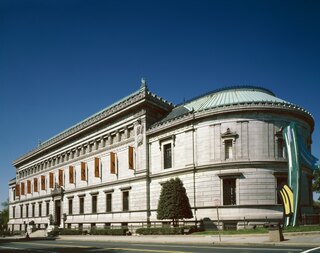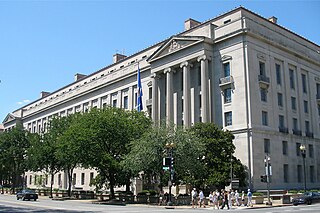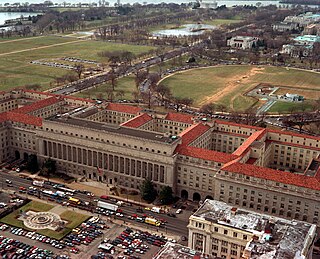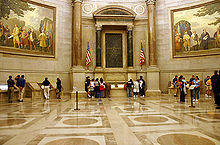
John Russell Pope was an American architect whose firm is widely known for designing major public buildings, including the National Archives and Records Administration building, the Jefferson Memorial and the West Building of the National Gallery of Art, all in Washington, D.C.

The Smithsonian Institution Building, more commonly known as the Smithsonian Castle or simply The Castle, is a building on the National Mall housing the Smithsonian Institution's administrative offices and information center. Built as the first Smithsonian museum building, it is constructed of Seneca red sandstone in the Norman Revival style. It was completed in 1855 and designated a National Historic Landmark in 1965.

The National Museum of American History: Kenneth E. Behring Center is a historical museum in Washington, D.C. It collects, preserves, and displays the heritage of the United States in the areas of social, political, cultural, scientific, and military history. Among the items on display is the original Star-Spangled Banner. The museum is part of the Smithsonian Institution and located on the National Mall at 14th Street and Constitution Avenue NW in Washington, D.C.

The Corcoran Gallery of Art is a former art museum in Washington, D.C., that is now the location of the Corcoran School of the Arts and Design, a part of the George Washington University.

Federal Triangle is a triangular area in Washington, D.C. formed by 15th Street NW, Constitution Avenue NW, Pennsylvania Avenue NW, and E Street NW. Federal Triangle is occupied by 10 large city and federal office buildings, all of which are part of the Pennsylvania Avenue National Historic Site. Seven of the buildings in Federal Triangle were built by the U.S. federal government in the early and mid-1930s as part of a coordinated construction plan that has been called "one of the greatest building projects ever undertaken" and all seven buildings are now designated as architecturally historic.

The term Charters of Freedom is used to describe the three documents in early United States history which are considered instrumental to its founding and philosophy. The documents include the United States Declaration of Independence, the Constitution, and the Bill of Rights. While the term has not entered particularly common usage, the room at the National Archives Building in Washington, D.C. that houses the three documents is called the Rotunda for the Charters of Freedom.

The John A. Wilson District Building, popularly known simply as the Wilson Building, houses the municipal offices and chambers of the Mayor and the Council of Washington, D.C. It was originally called the District Building. In 1994, it was renamed in recognition of former Council Chair John A. Wilson. Completed in 1908, during the administration of 26th President Theodore Roosevelt, the building is a contributing structure to the Pennsylvania Avenue National Historic Site.

The Robert F. Kennedy Department of Justice Building, sometimes called Main Justice, is the headquarters of the United States Department of Justice. It houses Department of Justice offices, including the office of the United States Attorney General. The building was completed in 1935. In 2001, it was renamed after Robert F. Kennedy, the 64th Attorney General of the United States.

The Herbert C. Hoover Building is the Washington, D.C. headquarters of the United States Department of Commerce.

The American Institute of Pharmacy Building, also known as the Americal Pharmaceutical Association Building and the American Pharmacists Association Building is a late Beaux Arts style building in Washington, D.C., the headquarters of the American Pharmacists Association. The building, prominently located on Constitution Avenue, is on the only privately held lot in the area, surrounded by protected Federal lands. It was listed on the National Register of Historic Places in 1977.

The Old Federal Building in Anchorage, Alaska is a structure serving primarily as a courthouse of the United States District Court for the District of Alaska. Completed in stages from 1939 to 1941, the building was listed in the National Register of Historic Places in 1978.

The Old Post Office, listed on the National Register of Historic Places as the Old Post Office and Clock Tower, is located at 1100 Pennsylvania Avenue, N.W. in Washington, D.C. It is a contributing property to the Pennsylvania Avenue National Historic Site. The building's 315-foot (96-meter) high clock tower houses the "Bells of Congress," and its observation level offers panoramic views of the city and its surroundings. A historic federal office building, it now serves as a hotel.

The Federal Office Building, Seattle, Washington is a historic federal office building located at Seattle in King County, Washington.

The Lafayette Building, also known as Export-Import Bank Building, is a federal government office building at 811 Vermont Avenue NW in Washington, D.C. Completed in 1940, it was declared a National Historic Landmark in 2005. Its landmark designation was made because it was home to the Reconstruction Finance Corporation, the government arm that financed and oversaw the mobilization of the United States economy during World War II. It is currently home to the Export–Import Bank of the United States and to offices of the United States Department of Veterans Affairs.

The Union Passenger Station in Tacoma, Washington, United States, opened in 1911. It was listed on the National Register of Historic Places in 1974. It now serves as a courthouse of the United States District Court for the Western District of Washington. The distinctive architecture, dominated by a copper dome, is a landmark for the area.
William Louis Ayres, better known by his professional name Louis Ayres, was an American architect who was one of the most prominent designers of monuments, memorials, and buildings in the nation in the early part of the 20th century. His style is characterized as Medievalist, often emphasizing elements of Romanesque Revival and Italian Renaissance, and Byzantine Revival architecture. He is best known for designing the United States Memorial Chapel at the Meuse-Argonne American Cemetery and Memorial and the Herbert C. Hoover U.S. Department of Commerce Building.

The American Veterans Disabled for Life Memorial is a memorial in Washington, D.C., which honors veterans of the armed forces of the United States who were permanently disabled during the course of their national service. Congress adopted legislation establishing the memorial on October 23, 2000, authorizing the Disabled Veterans for Life Memorial Foundation to design, raise funds for, and construct the memorial. The fundraising goal was reached in mid-2010 and ground for the memorial broken on November 10, 2010. The memorial was dedicated by President Barack Obama on October 5, 2014.

The James V. Forrestal Building is a low-rise Brutalist office building in Washington, D.C. Originally known as Federal Office Building 5, and nicknamed the Little Pentagon, the Forrestal Building was constructed between 1965 and 1969 to accommodate United States armed forces personnel. It is named after James Forrestal, the first United States Secretary of Defense. It became the headquarters of the United States Department of Energy after that agency's creation in 1977.

The Cleveland Trust Company Building is a 1907 building designed by George B. Post and located at the intersection of East 9th Street and Euclid Avenue in downtown Cleveland's Nine-Twelve District. The building is a mix of Beaux-Arts, Neoclassical, and Renaissance Revival architectural styles. It features a glass-enclosed rotunda, a tympanum sculpture, and interior murals.

The Freedman's Bank Building, previously known as the Treasury Annex, is a historic office building located on the corner of Madison Place and Pennsylvania Avenue NW in Washington, D.C. It sits on the east side of Lafayette Square, a public park on the north side of the White House, and across from the Treasury Building. The adjoining properties include the Howard T. Markey National Courts Building to the north and the former Riggs National Bank to the east.


























